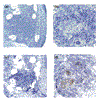Cell-cell interactions in synovitis. Interactions between T cells and B cells in rheumatoid arthritis
- PMID: 11094459
- PMCID: PMC128875
- DOI: 10.1186/ar128
Cell-cell interactions in synovitis. Interactions between T cells and B cells in rheumatoid arthritis
Abstract
In rheumatoid arthritis, T cells and B cells participate in the immune responses evolving in the synovial lesions. Interaction between T cells and B cells is probably antigen specific because complex microstructures typical of secondary lymphoid organs are generated. Differences between patients in forming follicles with germinal centers, T-cell-B-cell aggregates without germinal center reactions, or loosely organized T-cell-B-cell infiltrates might reflect the presence of different antigens or a heterogeneity in host response patterns to immune injury. Tertiary lymphoid microstructures in the rheumatoid lesions can enhance the sensitivity of antigen recognition, optimize the collaboration of immunoregulatory and effector cells, and support the interaction between the tissue site and the aberrant immune response. The molecular basis of lymphoid organogenesis studied in gene-targeted mice will provide clues to why the synovium is a preferred site for tertiary lymphoid tissue. B cells have a critical role in lymphoid organogenesis. Their contribution to synovial inflammation extends beyond antibody secretion and includes the activation and regulation of effector T cells.
Figures


References
-
- Fu YX, Chaplin DD. Development and maturation of secondary lymphoid tissues. Annu Rev Immunol. 1999;17:399–433. - PubMed
-
- Gretz JE, Anderson AO, Shaw S. Cords, channels, corridors and conduits: critical architectural elements facilitating cell interactions in the lymph node cortex. Immunol Rev. 1997;156:11–24. - PubMed
-
- Gretz JE, Kaldjian EP, Anderson AO, Shaw S. Sophisticated strategies for information encounter in the lymph node: the reticular network as a conduit of soluble information and a highway for cell traffic. . J Immunol. 1996;157:495–499. - PubMed
-
- Young CL, Adamson TC3, Vaughan JH, Fox RI. Immunohistologic characterization of synovial membrane lymphocytes in rheumatoid arthritis. . Arthritis Rheum. 1984;27:32–39. - PubMed
Publication types
MeSH terms
Grants and funding
LinkOut - more resources
Full Text Sources
Medical

